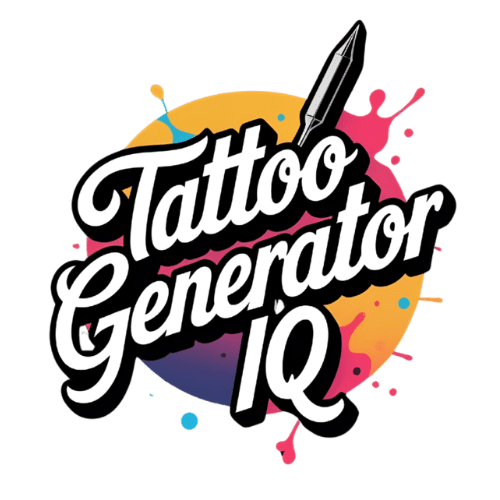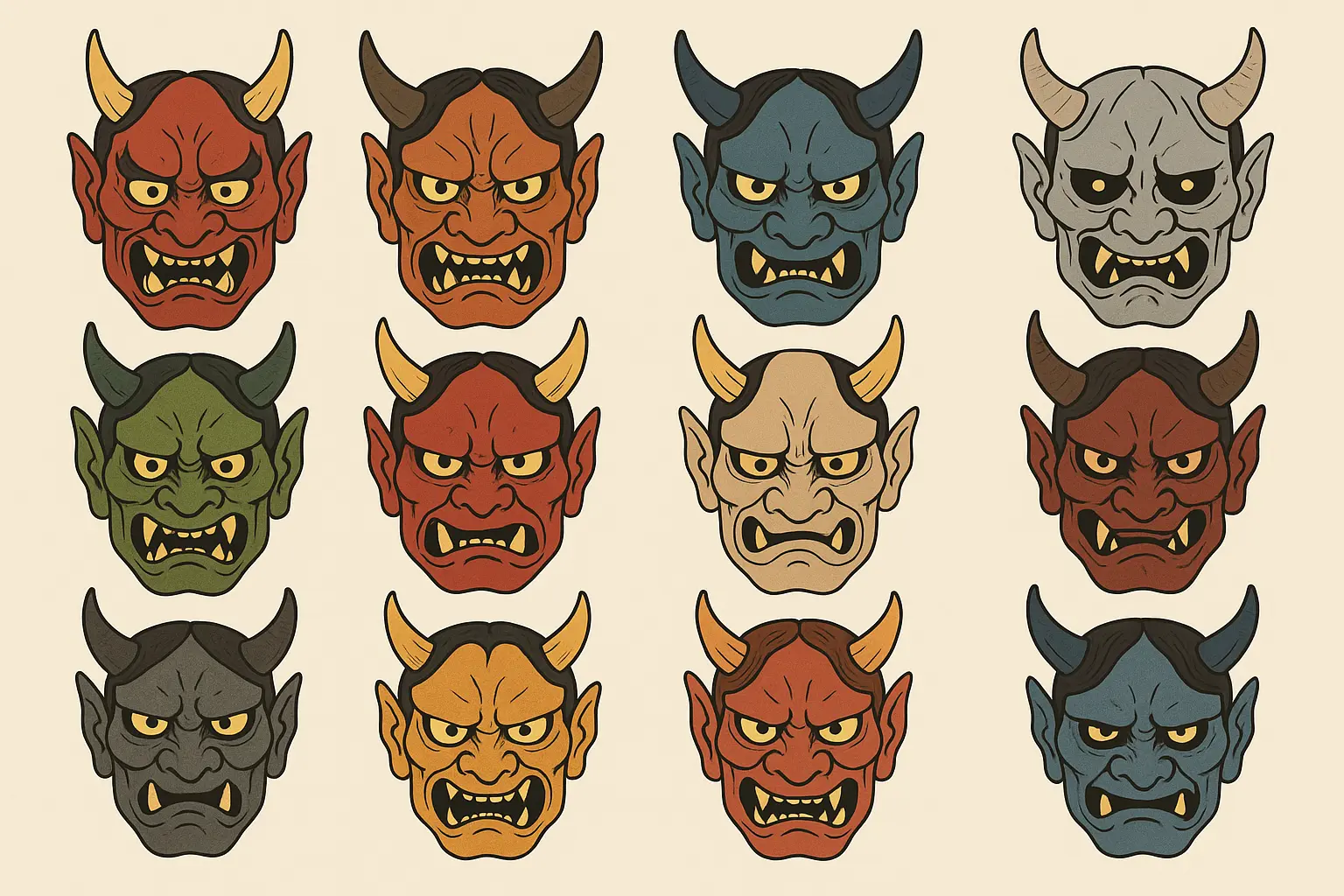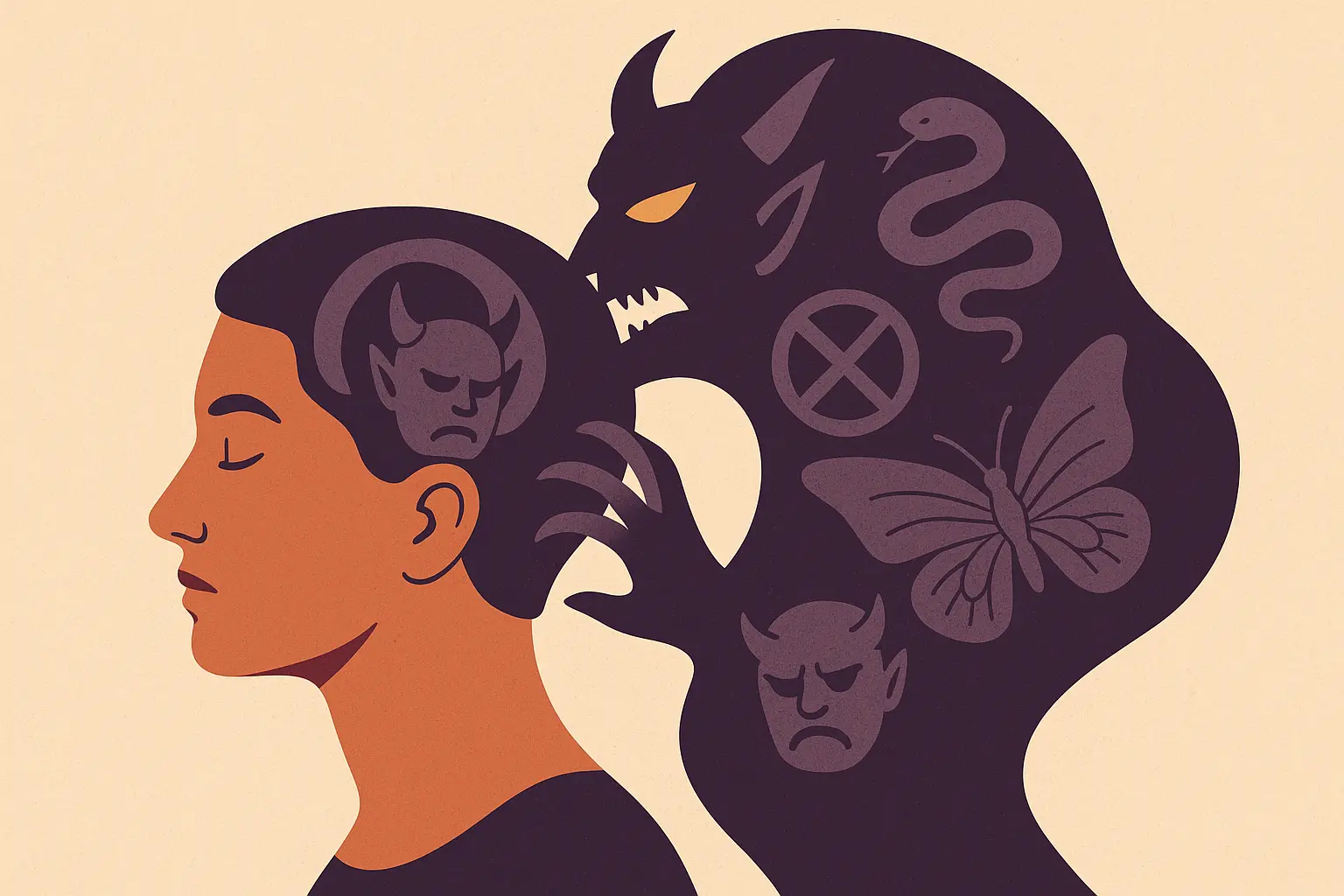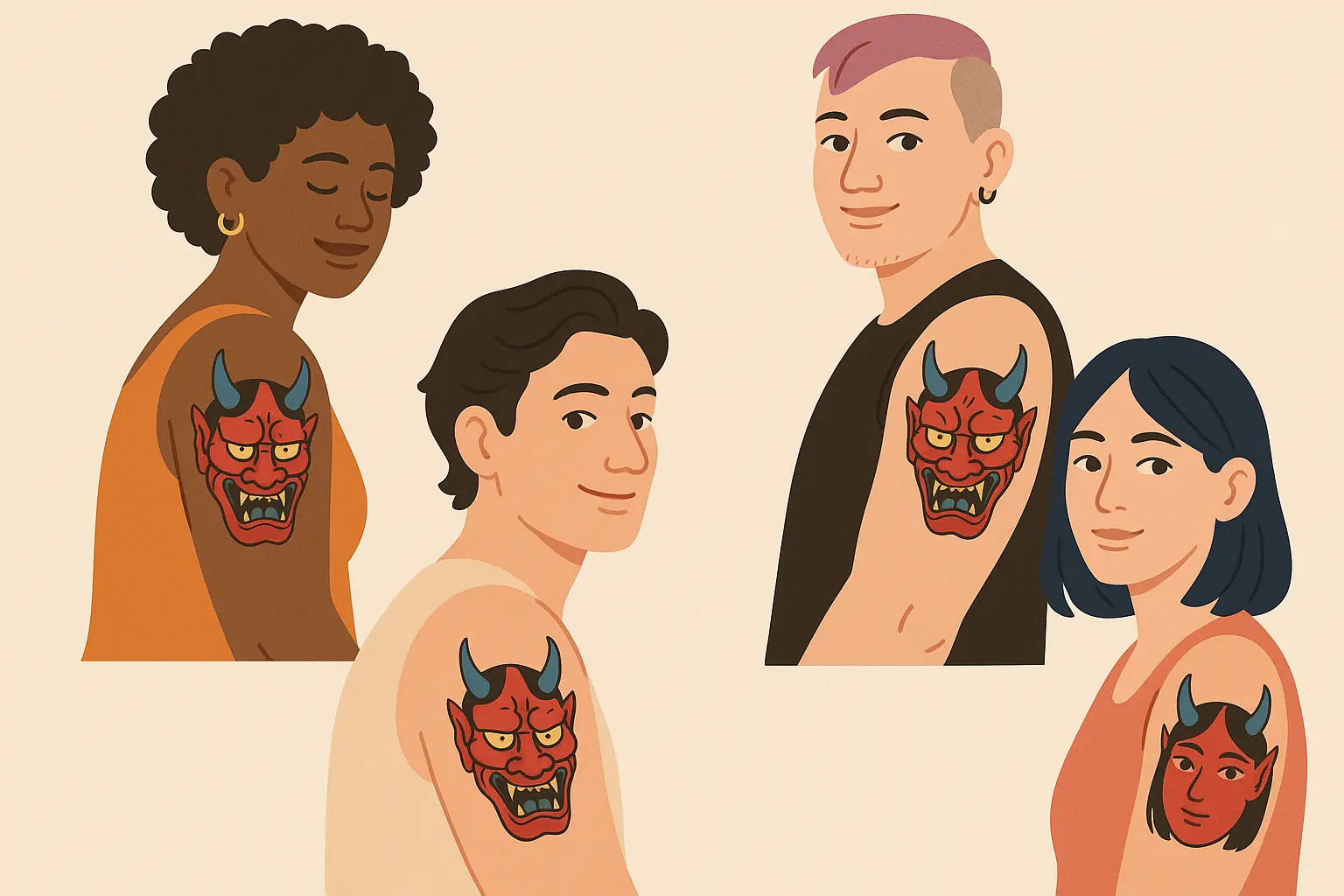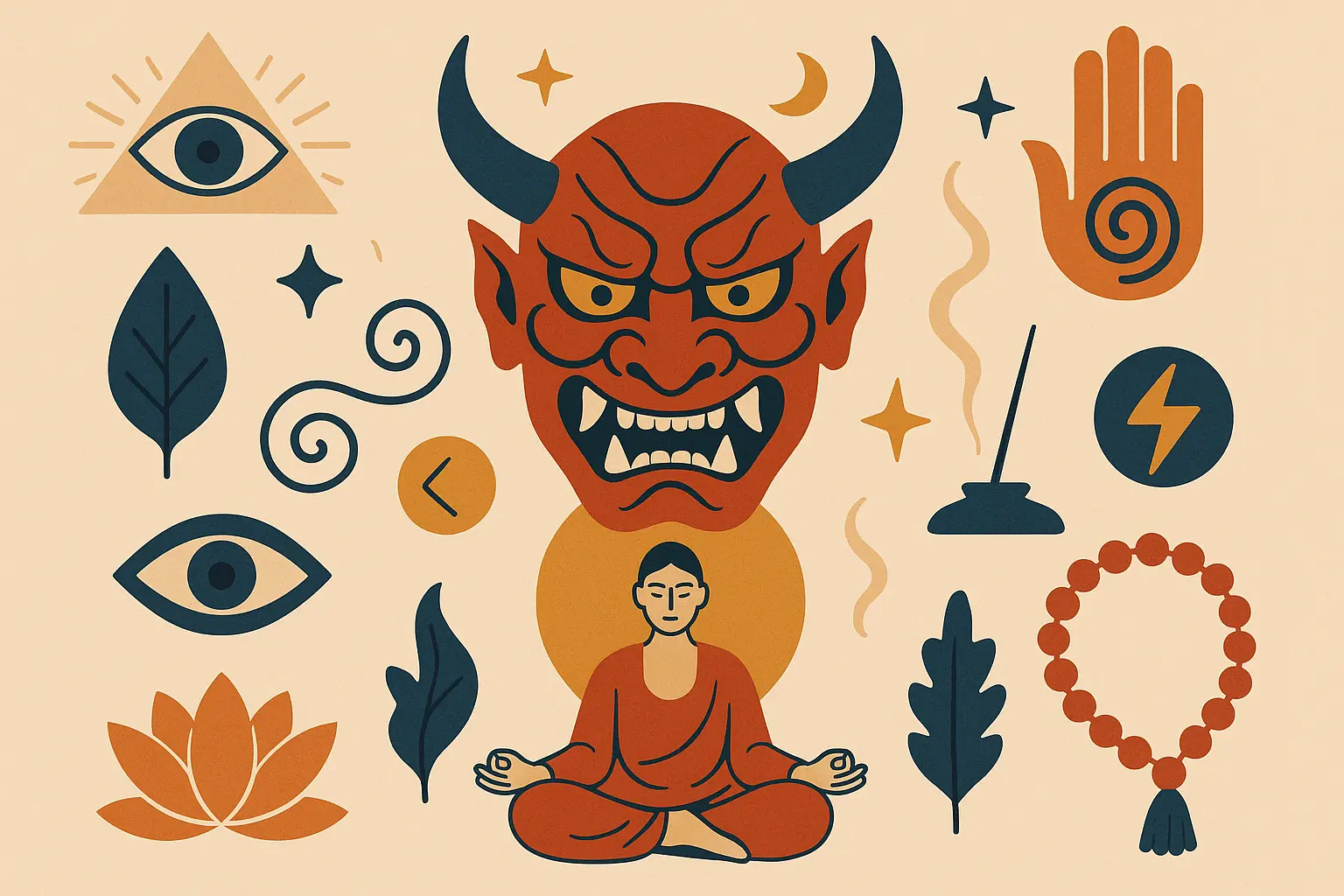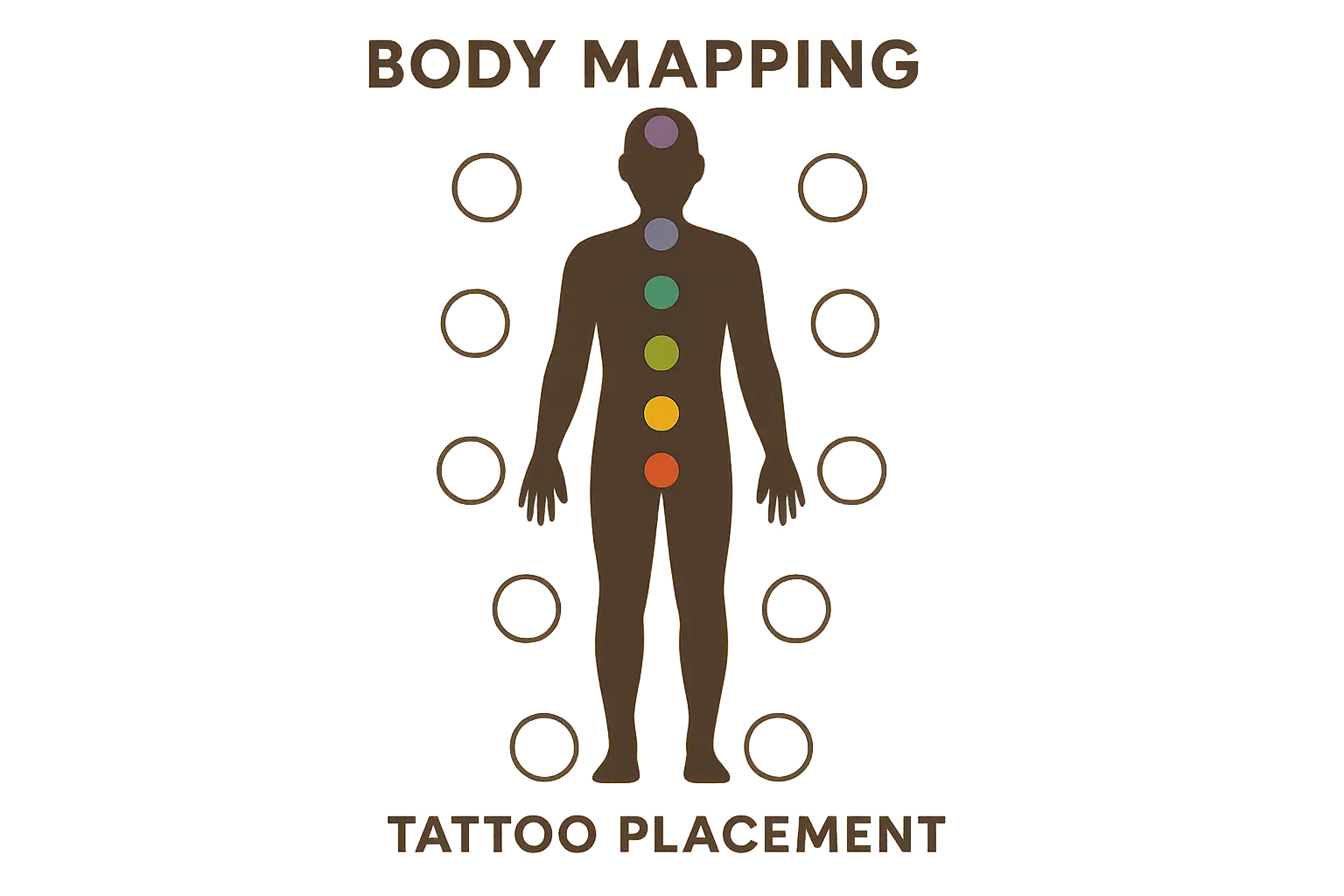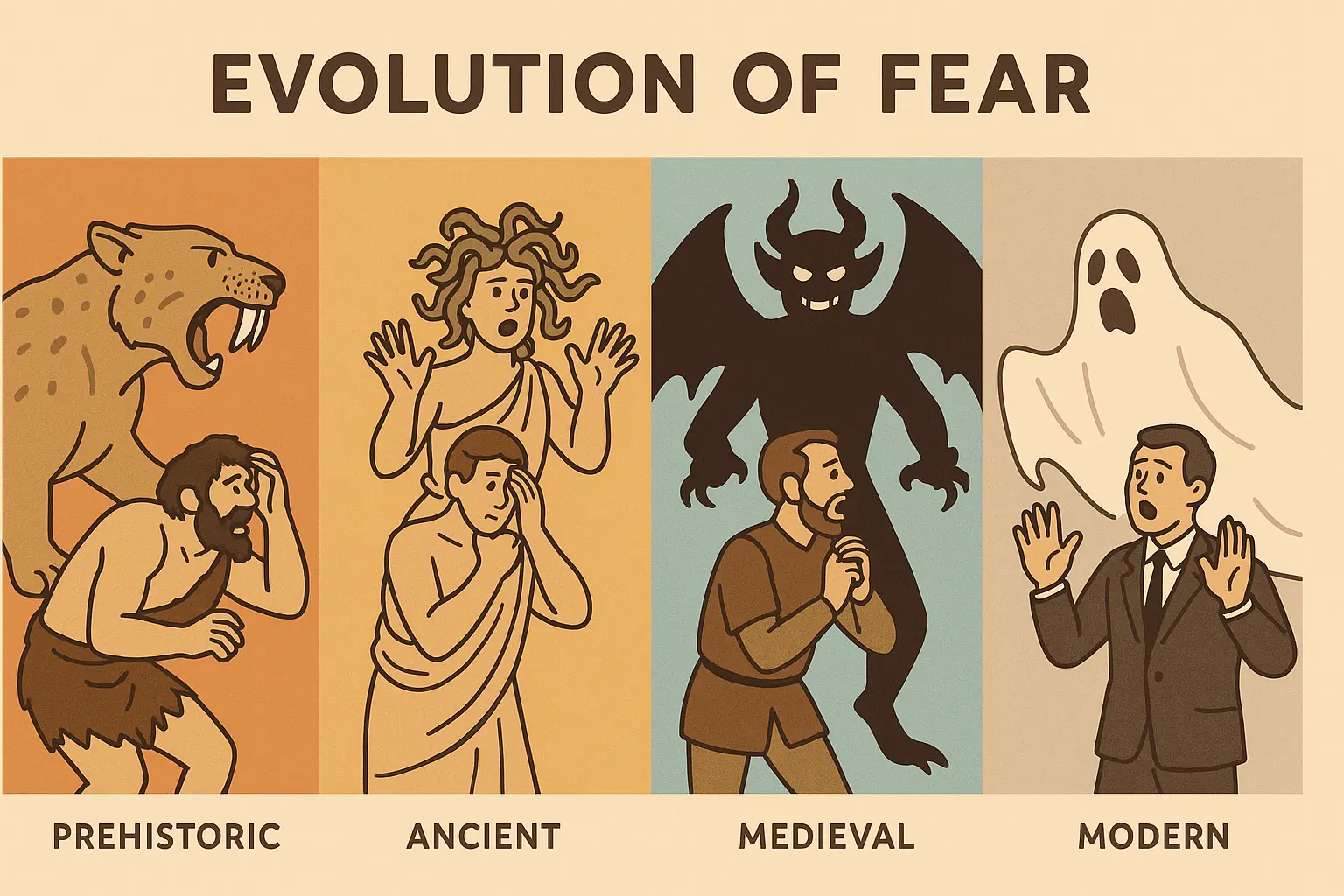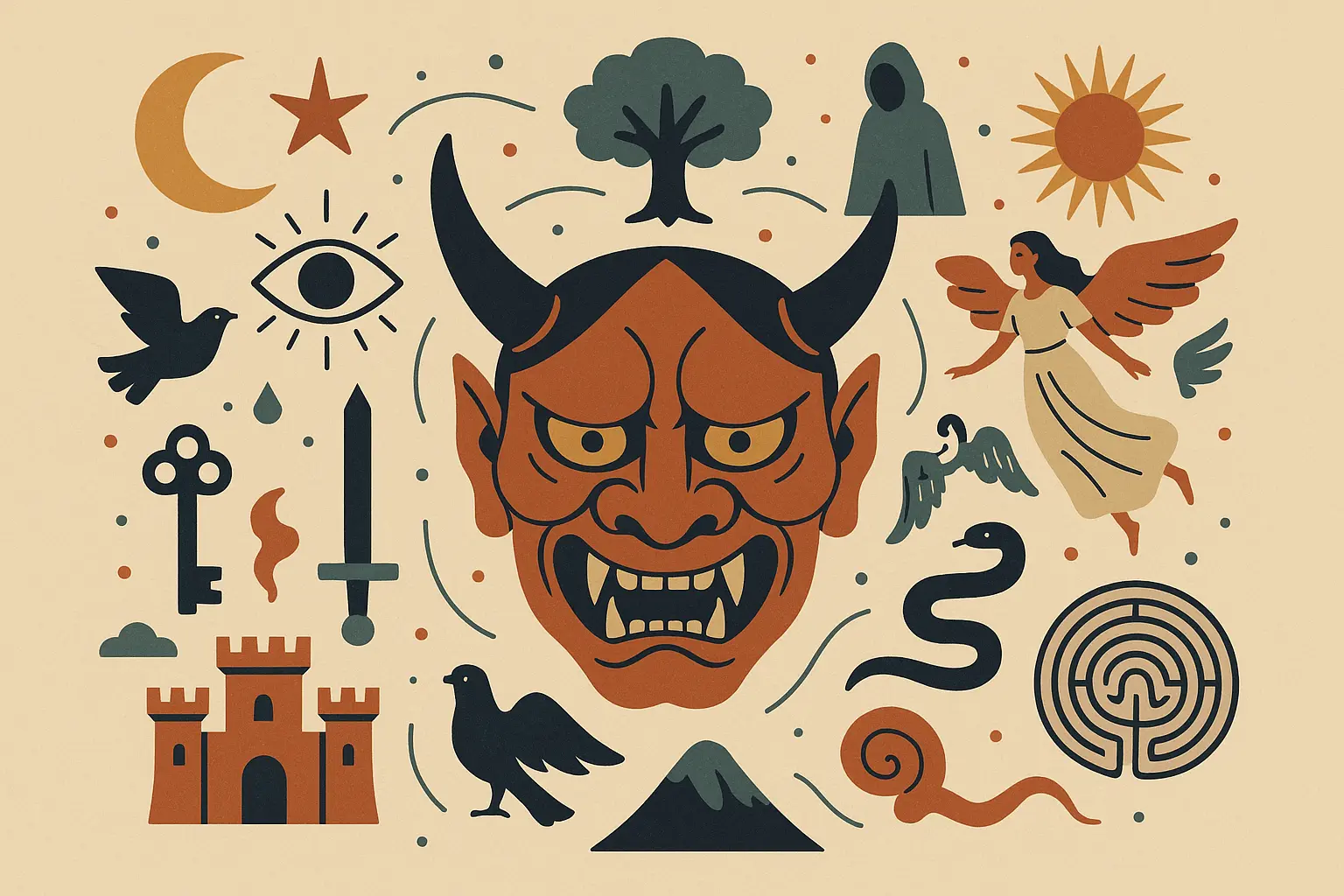Oni Mask Tattoo Meaning: The Dark Psychology Most People Never Talk About
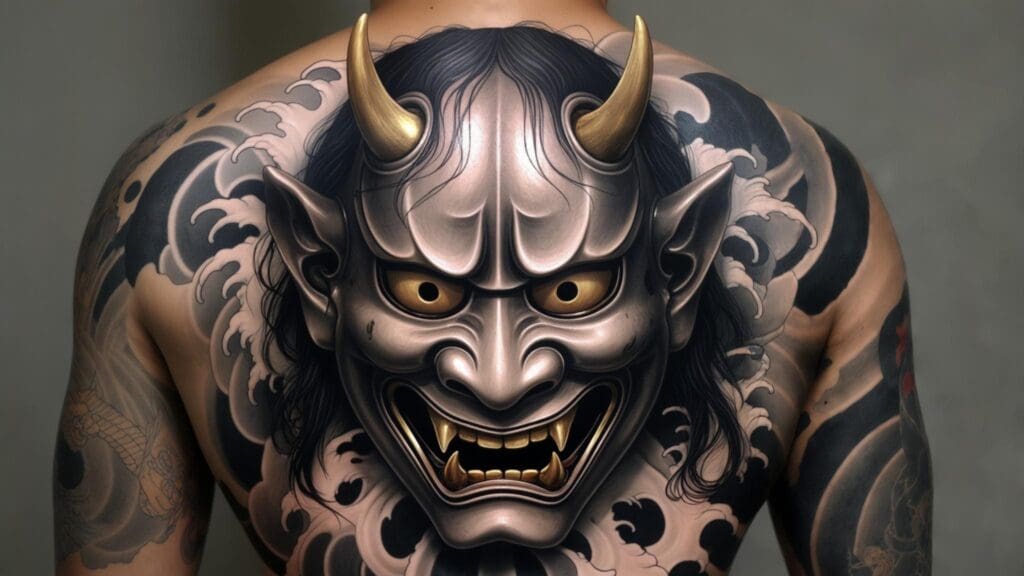
I keep seeing these incredible oni mask tattoos everywhere, and honestly? They’re way more complex than I first thought. These aren’t your typical flash art pieces that people grab off the wall. According to Tattoo Topia, these striking designs draw people in for their dramatic appearance and deep cultural significance rooted in Japanese folklore. But here’s what most people don’t realize – choosing an oni tattoo triggers some deep stuff going on in your head that goes way beyond wanting to look fierce or appreciate Japanese art.
The psychological impact of tattoos connects deeply to broader tattoo meaning concepts in modern culture. When I started researching this topic, I discovered layers of meaning that most tattoo enthusiasts never consider. We’re talking about shadow work, trauma processing, and spiritual transformation – all wrapped up in one oni tattoo design.
Table of Contents
-
Why You’re Actually Drawn to These Demon Faces (It’s Not What You Think)
-
Your Brain on Demonic Imagery: The Science Behind the Obsession
-
How to Not Be That Person Who Gets a Culturally Significant Tattoo Wrong
-
Breaking Gender Rules: When Women and Non-Binary Folks Choose Demons
-
Modern Shamanism: Your Tattoo as Spiritual Weapon
-
Body Placement Psychology: Where You Put It Changes Everything
-
The Evolutionary Reason We’re Drawn to Monsters
-
How Tattoo Generator IQ Helps You Navigate Cultural Complexity
TL;DR
-
Oni mask tattoos function as psychological tools for shadow work and trauma processing, not just decorative art
-
Cultural appropriation concerns require genuine research and collaboration with Japanese artists
-
Women and non-binary individuals use oni imagery to challenge traditional gender expectations
-
Tattoo placement affects psychological impact through ancient body mapping principles
-
The tattooing pain itself becomes a spiritual initiation ritual for many recipients
-
Evolutionary psychology explains our attraction to demonic archetypes as primal power absorption
-
Modern practitioners integrate oni tattoos into neo-shamanic spiritual practices
Why You’re Actually Drawn to These Demon Faces (It’s Not What You Think)
Okay, so here’s where things get weird (and fascinating). Most people think oni tattoos are just about looking badass or showing appreciation for Japanese culture. But after diving deep into this rabbit hole – and I mean deep – I discovered there’s some serious psychological stuff happening that most people never even consider.
Look, I know talking about “shadow work” and “trauma processing” sounds like I’ve been spending too much time on psychology forums, but hear me out. These demonic images aren’t just pretty pictures – they’re doing actual work in your brain.
The oni mask meaning extends into psychological territory that would make Carl Jung proud. We’re dealing with archetypal imagery that speaks to fundamental human experiences of power, transformation, and the integration of our shadow selves.
Your Shadow Self Needs an Exit Strategy
This is going to sound like I’ve been reading too much Carl Jung (guilty as charged), but we all have parts of ourselves we’d rather pretend don’t exist. You know what I’m talking about – that anger you never express, those dark thoughts you push down, the parts of your personality that don’t fit your “good person” image.
Here’s the thing: oni mask tattoos become like external hard drives for all that suppressed stuff. Instead of keeping it locked up inside where it can mess with you, you’re literally putting it on display. And somehow, that makes it less scary and more manageable.
I met this therapist named Sarah who got an oni mask on her shoulder after years of being the “nice girl” who never got angry. She told me something that stuck with me: “Having that fierce face visible helped me own my anger instead of being owned by it.” Now she’s actually better at her job because she’s not afraid of her clients’ rage – or her own.
The transformative power of tattoo imagery relates closely to other meaningful tattoo ideas that serve psychological purposes. When you’re dealing with shadow integration, you need imagery that can handle the psychological weight.
Making the Invisible Visible Through Ink
Every time you catch a glimpse of your oni tattoo, your brain is basically saying, “Oh yeah, that’s part of me too.” It’s like having a daily check-in with the parts of yourself you might otherwise ignore.
Your japanese demon tattoo becomes this weird kind of mirror that shows you the whole picture – not just the socially acceptable parts. And honestly? That’s pretty powerful stuff.
Trauma Gets a Face (And Fangs)
This part might sound intense, but stay with me. A lot of people I’ve talked to chose their oni design to represent something they survived. The demon’s fierce expression becomes like a “before and after” photo – showing both the struggle and the strength that came from getting through it.
According to research from Discover Magazine, oni are “considered to be evil, but not entirely evil,” with “lots of contradictory elements” that mirror the complexity of human psychology. This duality makes them perfect symbols for processing mixed emotions and complex trauma responses.
The oni tattoo doesn’t erase what happened to you. Instead, it transforms it into something you chose, something you control, something that represents your power rather than your pain.
Your Identity Reconstruction Project
The transformative nature of oni masks mirrors personal metamorphosis. People often report significant life changes after getting their oni tattoo – not because the ink is magic, but because the commitment to wearing such powerful imagery signals a deep internal shift in how they see themselves.
Your Subconscious Bodyguard System
Here’s something wild I learned: oni tattoos function as psychological protection mechanisms on multiple levels. They boost your internal confidence while creating external deterrent effects. Your brain literally feels safer when you’re displaying fierce imagery, and others unconsciously respond to these primal visual cues.
The Intimidation Factor You Didn’t Know You Wanted
People give you more space (literally and figuratively) when you’re wearing a demon face, and you feel more confident because your subconscious thinks you are the powerful thing you’re displaying. Your oni mask is basically doing the heavy lifting in social situations before you even open your mouth.
Becoming What You Display
Here’s something that blew my mind – wearing traditionally frightening imagery actually reduces your own fear responses. Your brain psychologically merges with the powerful symbol you’re displaying, making you feel more confident and capable in challenging situations.
How to Not Be That Person Who Gets a Culturally Significant Tattoo Wrong
Alright, let’s talk about the elephant in the room. Getting an oni tattoo means you’re stepping into some seriously complex cultural territory, and I’ve seen way too many people mess this up spectacularly.
This isn’t like choosing a butterfly or a tribal design from a flash sheet. You’re dealing with centuries of Japanese culture, religion, and artistic tradition. Understanding cultural significance in tattoos extends to other traditional designs like Japanese traditional tattoos that require similar respect and research. When you put this imagery on your body, you’re joining a conversation that’s way bigger than your personal aesthetic preferences.
I’ll be honest – I almost made some major mistakes when I first started researching this. I thought I could just Google “oni meaning” and call it good. Spoiler alert: I was wrong.
The japanese demon tattoo carries centuries of cultural meaning, religious significance, and artistic tradition. When you choose to wear this imagery, you’re participating in a cultural conversation that extends far beyond your personal aesthetic preferences.
|
Cultural Research Checklist |
Description |
Importance Level |
|---|---|---|
|
Study oni folklore origins |
Understanding historical context and regional variations |
Critical |
|
Learn color significance |
Red vs blue oni meanings and spiritual implications |
High |
|
Research artistic traditions |
Traditional Japanese tattooing techniques and symbolism |
High |
|
Consult cultural experts |
Speaking with Japanese artists or cultural historians |
Critical |
|
Understand religious context |
Oni’s role in Buddhism and Shintoism |
Medium |
|
Study modern interpretations |
How oni meaning has evolved in contemporary Japan |
Medium |
Your Cultural Homework Assignment (Yes, It’s Actually Required)
If you’re serious about getting an oni tattoo, you need to do some real research. And I don’t mean spending twenty minutes on Wikipedia. We’re talking about understanding the difference between protective and malevolent oni (yes, there’s a difference), learning why red demons mean something different than blue ones, and figuring out which type of oni actually represents what you’re trying to express.
The Research Deep Dive You Actually Need to Do
Essential steps include studying primary academic sources on Japanese oni mythology, consulting with cultural experts, understanding the difference between protective and malevolent oni, and researching specific oni types. Red versus blue demons carry distinct meanings that affect your tattoo’s cultural authenticity.
According to Eiyo Kimono, traditionally around 60 different types of Noh masks existed, but today this number is much higher, with each mask representing specific characters and cultural meanings within Japanese popular media and traditional storytelling.
Your oni tattoo research should go beyond surface-level Wikipedia articles. You need to understand the nuanced differences between protective oni and malevolent ones, the significance of different facial expressions, and how these meanings have evolved over time.
Finding Your Cultural Guide
The best advice I can give? Work with artists who have genuine connections to Japanese tattooing traditions. These folks can help you understand what you’re actually putting on your body and guide you toward choices that honor the culture instead of just borrowing from it.
Making It Yours Without Making It Wrong
You can absolutely create something personal and meaningful while still respecting the cultural foundation. The key is understanding that framework first, then finding authentic ways to weave your story into it.
Fusion Without Confusion
Guidelines for combining oni elements with other cultural or artistic styles focus on maintaining respect for the original symbolism. You can create something unique while still honoring the cultural foundation that makes oni imagery so powerful.
Japanese demon tattoos work best when they maintain the essential elements that give them their cultural power while incorporating personal touches that reflect your individual journey.
Where Creative Freedom Meets Cultural Boundaries
Your personal meaning should add to the cultural significance, not replace it. Methods for incorporating individual significance into oni designs involve understanding the cultural framework first, then finding authentic ways to weave your personal story into that foundation.
Breaking Gender Rules: When Women and Non-Binary Folks Choose Demons
Here’s something that really got my attention: the number of women and non-binary people choosing oni tattoos. And honestly? It makes perfect sense once you think about it.
Society has some pretty rigid ideas about what kind of imagery women “should” display on their bodies. Spoiler alert: fierce demon faces usually don’t make the approved list. But more and more people are saying “screw that” and embracing the full spectrum of their personality – including the parts that society tries to keep under wraps.
Oni tattoos challenge the notion that women should only display gentle, pretty imagery. They’re embracing the full spectrum of feminine power, including its protective and transformative aspects. The japanese demon tattoo becomes a statement of complexity and strength that refuses to be diminished.
Fierce Femininity Isn’t an Oxymoron
I talked to Maria, a single mom and nurse who got a blue oni mask on her forearm after her divorce. She put it perfectly: “It represents the fierce protector I became for my children. When people see it, they understand I’m not someone to mess with when it comes to my family’s safety.”
Her oni tattoo isn’t about being aggressive – it’s about owning the protective, powerful aspects of femininity that don’t fit into the “nice girl” box.
The Mama Bear in Demon Form
Women often interpret oni masks as representations of fierce maternal protection – the lengths they’d go to defend their children or loved ones. This isn’t about aggression; it’s about the primal protective instinct that society often tries to sanitize or ignore.
Her oni tattoo serves as both personal reminder and public declaration. She’s claiming space for the protective aspects of femininity that don’t fit into traditional “nice girl” expectations.
Rejecting the “Nice Girl” Prison
Choosing to display traditionally masculine, frightening imagery serves as a rejection of societal expectations for feminine gentleness and submission. It’s a visual statement that says “I contain multitudes, and I’m not apologizing for my complexity.”
Beyond the Binary: Oni as Identity Mirror
For people who exist outside traditional gender categories, oni masks offer something really powerful. These demons are shapeshifters in folklore – they transform, they refuse simple categorization, and they represent the kind of fluidity that resonates with non-binary experiences.
Fluidity in Fierce Form
The shapeshifting abilities attributed to oni in folklore resonate deeply with individuals whose
The shapeshifting abilities attributed to oni in folklore resonate deeply with individuals whose gender expression is fluid or evolving. These tattoos become visual representations of identity that refuses to be pinned down or easily categorized.
The oni tattoo becomes a perfect metaphor for gender fluidity – powerful, transformative, and impossible to contain within simple categories.
Transformation as Truth
For many non-binary individuals, the transformative symbolism of oni masks reflects their own journey of becoming. The tattoo serves as both a marker of change and a commitment to continued evolution.
Modern Shamanism: Your Tattoo as Spiritual Weapon
Okay, this is where things might sound a little out there, but stick with me. I’ve discovered that a lot of people are using their oni tattoos as actual spiritual tools, not just body art.
I’m not talking about cultural appropriation of shamanic traditions – I’m talking about how ancient spiritual concepts are showing up in modern contexts. Contemporary spiritual practitioners are discovering that oni mask tattoos function as more than body art – they’re permanent ritual objects and spiritual anchors.
The spiritual aspects of tattoos connect to broader spiritual tattoo ideas that serve similar protective and transformative purposes. Oni tattoos take this concept to another level because of their inherent spiritual significance in Japanese culture.
Modern practitioners integrate japanese oni tattoo imagery into their spiritual toolkit, using these tattoos as focal points for meditation, protection work, and spiritual communication. The permanent nature of tattoos makes them particularly powerful for ongoing spiritual practices that require consistent visual and energetic anchors.
Your Permanent Spirit Guide Connection
Some people I’ve met view their oni tattoos as permanent connections to protective spirits. They use the imagery as a focal point for meditation, create rituals around it, and basically treat it like a spiritual antenna.
Now, whether you believe in the metaphysical aspects or just see it as powerful psychology, the protective feeling these tattoos provide can seriously impact your confidence and resilience.
Neo-Shamanic Practice Integration
Modern practitioners incorporate oni imagery into their spiritual toolkit, using these tattoos as focal points for meditation, protection work, and spiritual communication. This involves establishing meditation practices focused on the tattoo, creating rituals that honor its spiritual significance, and studying traditions that work with fierce protector spirits.
Your oni tattoo becomes more than decoration – it’s a spiritual antenna that helps you connect with protective energies and fierce wisdom traditions.
Ritual Empowerment Through Ink
I’ve seen people use their oni tattoos as focal points for personal empowerment rituals, drawing on the demon’s fierce energy for spiritual protection and strength. These practices often involve energy work, visualization techniques, and ceremonial acknowledgment of the tattoo’s spiritual function.
Your Energetic Armor System
The belief that oni tattoos create energetic shields against negative influences functions as spiritual armor in daily life. Whether you view this metaphysically or psychologically, the protective feeling these tattoos provide can significantly impact your confidence and resilience.
Body Placement Psychology: Where You Put It Changes Everything
Here’s something most people don’t think about: where you put your oni tattoo completely changes how it affects you psychologically and spiritually. This isn’t just about aesthetics – different placements create different psychological impacts.
I know this might sound like mystical nonsense, but it’s actually based on centuries of understanding about how imagery interacts with your body’s energy systems and psychological responses. Understanding tattoo placement pain levels is crucial, which connects to comprehensive tattoo pain scale information for making informed decisions. The pain you endure to get your oni tattoo becomes part of its spiritual significance.
Where you place your oni tattoo determines how it interacts with your daily life, your energy systems, and your psychological state. This isn’t mystical nonsense – it’s based on centuries of understanding about how imagery interacts with the body’s energy systems and psychological responses.
|
Body Placement |
Psychological Effect |
Spiritual Significance |
Visibility Level |
|---|---|---|---|
|
Chest |
Personal power, heart protection |
Heart chakra alignment |
Medium-High |
|
Shoulder/Upper Arm |
Social confidence, strength display |
Warrior energy |
High |
|
Back |
Hidden strength, personal transformation |
Spiritual protection |
Low-Medium |
|
Forearm |
Daily reminder, active protection |
Manifestation energy |
Very High |
|
Thigh |
Personal empowerment, hidden power |
Root chakra grounding |
Low |
|
Hand |
Bold statement, constant presence |
Direct action energy |
Maximum |
The Mirror Effect of Facial Proximity
Oni masks placed on your shoulders, chest, or arms create this weird psychological mirroring effect where you unconsciously start adopting the demon’s fierce confidence. The closer it is to your face, the stronger this integration becomes.
It’s like your brain starts thinking, “Oh, I guess I’m the kind of person who displays fierce imagery,” and then you start acting accordingly.
Sacred Geometry Body Mapping
Traditional Japanese tattoo placement follows specific energetic principles designed to maximize the oni’s protective and transformative power. These aren’t arbitrary traditions – they’re based on centuries of understanding about how imagery interacts with the body’s energy systems and psychological responses.
Energy Center Alignment Strategy
Positioning oni masks to align with specific chakras or energy centers amplifies their intended effects. Root chakra placement enhances protection and grounding, while solar plexus positioning supports personal power and transformation. Understanding these connections helps you choose placement that supports your specific goals.
Living Art Through Movement
How muscle movement and body dynamics affect the oni’s expression creates artwork that changes with physical activity and emotional states. Placement on areas with significant muscle movement can make your tattoo feel more alive and responsive to your internal states.
Pain Processing and Spiritual Initiation
Here’s something interesting: a lot of oni tattoo recipients tell me that enduring the tattooing pain created a spiritual bond with the imagery. They view the ordeal as earning the right to wear such powerful symbolism.
Earning Your Demon Through Endurance
Many oni tattoo recipients report that enduring the tattooing pain creates a spiritual bond with the imagery. They view the ordeal as earning the right to wear such powerful symbolism, creating a deeper psychological connection than tattoos acquired without significant discomfort.
Transforming Pain Into Power
James, a military veteran with PTSD, chose to get his oni mask over several long, painful sessions specifically to work through trauma. He found that focusing on the oni’s protective energy during the tattooing process helped him reframe his relationship with physical and emotional pain.
The controlled pain of tattooing can serve as a healing ritual, transforming past trauma into empowering body art under the protection of the oni’s fierce energy. This process requires careful consideration and often benefits from therapeutic support, but can be profoundly healing when approached mindfully.
The Evolutionary Reason We’re Drawn to Monsters
Why are humans across cultures drawn to demonic imagery? It’s not random, and it’s not just cultural – we’re actually hardwired to respond to these visual cues in powerful ways.
Understanding why humans across cultures are drawn to demonic imagery reveals deep psychological needs that oni mask tattoos fulfill in modern society. This attraction isn’t random or purely cultural – it’s rooted in evolutionary psychology and our species’ relationship with power, fear, and survival.
The oni tattoo meaning extends beyond cultural symbolism into fundamental human psychology. We’re hardwired to respond to certain visual cues, and japanese demon tattoo imagery triggers these ancient recognition patterns in powerful ways.
Predator Mimicry Advantages
Displaying oni features triggers ancient recognition patterns in people’s brains. Your brain is essentially borrowing the psychological impact of predator characteristics to enhance your social position and personal security. You get the benefits of looking fierce without having to actually be aggressive.
Primal Fear Integration
Oni masks tap into evolutionary fear responses while simultaneously providing mastery over those fears through permanent embodiment. This psychological process helps you integrate primal fears rather than being controlled by them, creating a sense of empowerment and resilience.
Modern Tribal Belonging Signals
Oni tattoos function as contemporary tribal markings, signaling membership in alternative communities and shared values around strength, transformation, and authenticity. These visual cues help you find your tribe and communicate your values without verbal explanation.
Archetypal Power Absorption
When you permanently put powerful mythological imagery on your body, you’re not just wearing a picture – you’re psychologically integrating archetypal power that has resonated with humans for thousands of years.
Hero’s Journey Embodiment
Oni masks represent the confrontation with the shadow self that’s essential to psychological maturation, making the mythological hero’s journey visible and permanent on your body. This serves as a constant reminder of your capacity for growth and transformation.
Collective Unconscious Access
Your oni tattoo connects you to something bigger than individual experience. It taps into shared human wisdom about transformation, protection, and the integration of our darker aspects.
How Tattoo Generator IQ Helps You Navigate Cultural Complexity
Look, after everything I’ve learned about oni tattoos, I realize you need more than just a pretty picture. You need tools that understand both cultural authenticity and personal meaning.
The complex psychological and spiritual dimensions of oni mask tattoos require sophisticated design tools that understand both cultural authenticity and personal meaning. Tattoo Generator IQ’s advanced technology and educational approach ensure your oni design captures these deeper elements while maintaining cultural respect and supporting your individual transformation journey.
For those considering other Japanese-inspired designs, exploring traditional Japanese tattoo designs can provide additional cultural context and design inspiration. The oni mask tattoo meaning becomes clearer when you understand the broader artistic and spiritual traditions it emerges from.
When you’re dealing with culturally significant imagery that carries this much psychological weight, you need more than a pretty picture. Tattoo Generator IQ’s platform provides the cultural context and design sophistication necessary to create meaningful oni mask tattoos that serve your deepest needs while respecting Japanese traditions.
The platform’s placement guides help you understand how different anatomical locations affect your tattoo’s psychological impact, while custom style blending allows you to incorporate personal archetypal elements that resonate with your transformation journey. Whether you’re seeking primal empowerment, spiritual protection, or psychological integration, you’ll find the professional-quality designs and cultural guidance you need.
Your japanese oni tattoo deserves the same level of thoughtfulness and cultural awareness that went into its original creation centuries ago. The platform ensures you’re not just getting a cool design – you’re participating in a meaningful cultural and psychological tradition.
Ready to explore oni designs that honor both cultural tradition and your personal journey? Check out Tattoo Generator IQ’s oni mask collection and discover how the right design can support your psychological and spiritual goals.
Final Thoughts
Oni mask tattoos are way more than cool designs – they’re psychological tools, spiritual anchors, and cultural bridges that deserve serious consideration. Whether you’re drawn to their shadow integration potential, their role in challenging gender expectations, or their function as modern spiritual tools, these images require respect and understanding.
The journey of getting an oni mask tattoo becomes part of its meaning. From the initial psychological attraction to the cultural research, from the pain of application to the daily experience of wearing such powerful imagery, every aspect contributes to the tattoo’s transformative potential. Your oni mask isn’t decoration – it’s a commitment to embracing the full complexity of human experience.
Cultural respect and personal meaning aren’t mutually exclusive. You can honor Japanese traditions while creating something deeply personal and transformative. The key is approaching this process with genuine curiosity, respect, and willingness to do the work required to understand what you’re choosing to permanently display on your body.
For those ready to begin their tattoo journey, understanding the complete tattoo aftercare process ensures your oni mask heals properly and maintains its powerful symbolism for years to come. Your psychological and spiritual investment deserves proper physical care to match.
